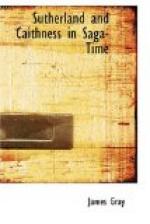As time went on, the Gaelic strain predominated more and more, especially on the mainland of Scotland, over the Gall, or foreign, strain, which was not maintained. Mr. A.W. Johnston, in his “Orkney and Shetland Folk—850 to 1350,"[14] has worked out the quarterings of the Norse jarls, of whom only the first three were pure Norsemen, and he has thus shown conclusively how very Celtic they had become long before their male line failed. The same process was at work, probably to a greater extent, among those of lower rank, who could not find or import Norse wives, if they would, as the jarls frequently did.
One or two other introductory points remain to be noted and borne in mind throughout.
We must beware of thinking that all the land in an earldom such as Cat was the absolute property of the chief, as in the nineteenth century, or the latter half of it, was practically true in the modern county of Sutherland. The fact was very much otherwise. The Maormor and afterwards the earl doubtless had demesne lands, but he was in early times, ex officio, mainly a superior and receiver of dues for his king;[15] and this possibly shows why very early Scottish earldoms, as for instance that of Sutherland, in the absence of male heirs, often descended to females, unless the grant or custom excluded them. It was quite different with later feudal baronies or tenancies, where military service, which only males could render, was due, and which with rare exceptions it was, after about 1130, the policy of the Scottish kings to create; and in the case of baronies or lordships the land itself was often described and given to the grantee and his heirs by metes and bounds, in return for specified military service, and his heirs male were exhausted before any female could inherit.
In Ness and in the rest of Cat there were many Norse and native holders of land within the earldom, and much tribal ownership. Duncan of Duncansby or Dungall of Dungallsby, as he is variously called, allowed part at least of his dominions to pass by marriage to the Norse jarls; but both Moddan and Earl Ottar, whose heir was Earl Erlend Haraldson, who left no heir, owned land extensively in Ness and elsewhere, while Moddan “in Dale” had daughters also owning land, one of whom, Frakark, widow of Liot Nidingr, had many homesteads in upper Kildonan in Sudrland and elsewhere, and possibly it is her sister Helga’s name that lingers in a place-name lower down that strath near Helmsdale, at Helgarie.




